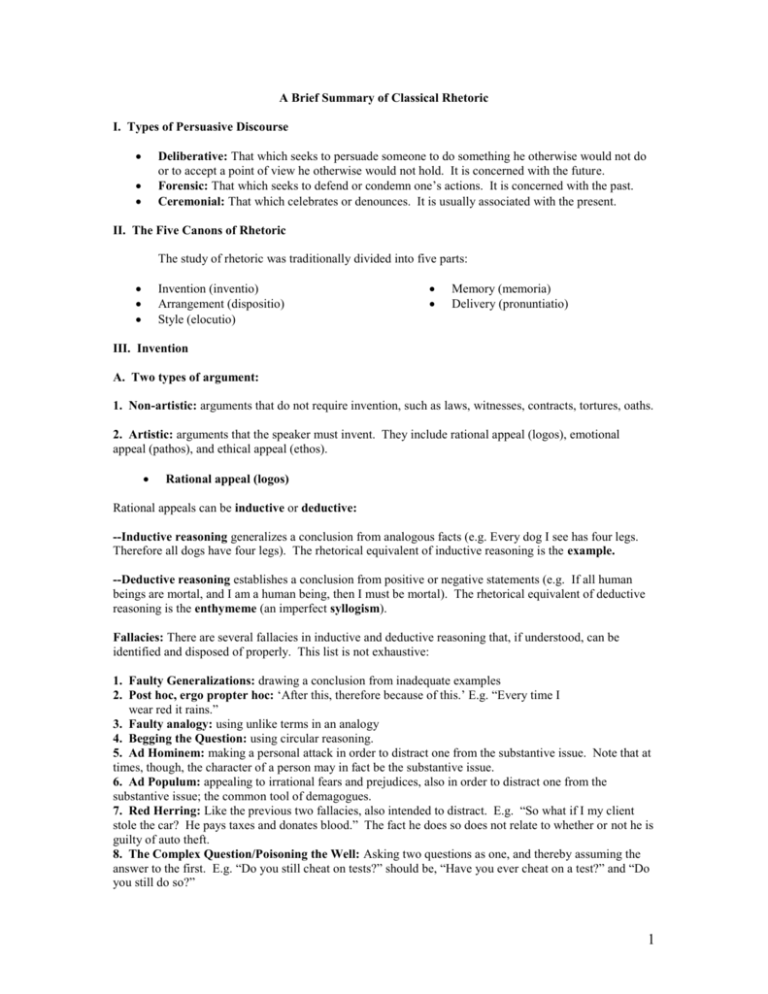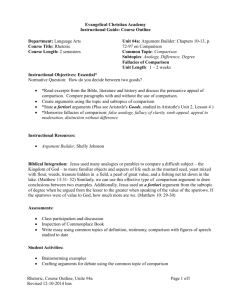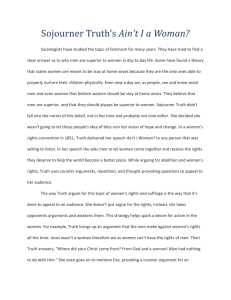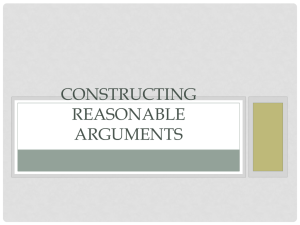A Brief Summary of Classical Rhetoric
advertisement

A Brief Summary of Classical Rhetoric I. Types of Persuasive Discourse Deliberative: That which seeks to persuade someone to do something he otherwise would not do or to accept a point of view he otherwise would not hold. It is concerned with the future. Forensic: That which seeks to defend or condemn one’s actions. It is concerned with the past. Ceremonial: That which celebrates or denounces. It is usually associated with the present. II. The Five Canons of Rhetoric The study of rhetoric was traditionally divided into five parts: Invention (inventio) Arrangement (dispositio) Style (elocutio) Memory (memoria) Delivery (pronuntiatio) III. Invention A. Two types of argument: 1. Non-artistic: arguments that do not require invention, such as laws, witnesses, contracts, tortures, oaths. 2. Artistic: arguments that the speaker must invent. They include rational appeal (logos), emotional appeal (pathos), and ethical appeal (ethos). Rational appeal (logos) Rational appeals can be inductive or deductive: --Inductive reasoning generalizes a conclusion from analogous facts (e.g. Every dog I see has four legs. Therefore all dogs have four legs). The rhetorical equivalent of inductive reasoning is the example. --Deductive reasoning establishes a conclusion from positive or negative statements (e.g. If all human beings are mortal, and I am a human being, then I must be mortal). The rhetorical equivalent of deductive reasoning is the enthymeme (an imperfect syllogism). Fallacies: There are several fallacies in inductive and deductive reasoning that, if understood, can be identified and disposed of properly. This list is not exhaustive: 1. Faulty Generalizations: drawing a conclusion from inadequate examples 2. Post hoc, ergo propter hoc: ‘After this, therefore because of this.’ E.g. “Every time I wear red it rains.” 3. Faulty analogy: using unlike terms in an analogy 4. Begging the Question: using circular reasoning. 5. Ad Hominem: making a personal attack in order to distract one from the substantive issue. Note that at times, though, the character of a person may in fact be the substantive issue. 6. Ad Populum: appealing to irrational fears and prejudices, also in order to distract one from the substantive issue; the common tool of demagogues. 7. Red Herring: Like the previous two fallacies, also intended to distract. E.g. “So what if I my client stole the car? He pays taxes and donates blood.” The fact he does so does not relate to whether or not he is guilty of auto theft. 8. The Complex Question/Poisoning the Well: Asking two questions as one, and thereby assuming the answer to the first. E.g. “Do you still cheat on tests?” should be, “Have you ever cheat on a test?” and “Do you still do so?” 1 Ethical Appeal (ethos) A second type of artistic argument is the speaker’s character, not only as established by his reputation, but also as conveyed in the speech itself. Most orators agree that one’s character is the most potent weapon in one’s rhetorical arsenal. Emotional Appeal (pathos) The final type of artistic argument is an appeal to the emotion of the audience. Pathos should never be substituted for proper rational argument, but rather should buttress it. B. The Topics (topoi) Classical rhetoricians invented the topics as an aid to discovering argument. Though the topics are helpful, they cannot substitute for broad knowledge of the world acquired through dedicated study and experience. --Definition 1. Genus 2. Division --Comparison 1. Similarity 2. Difference 3. Degree --Relationship 1. Cause and Effect 2. Antecedent and Consequence 3. Contraries 4. Contradictories --Circumstance 1. Possible and Impossible 2. Past fact and future fact --Testimony (non-artistic arguments) 1. Authority 2. Testimonial 3. Statistics 4. Maxims 5. Laws 6. Precedents In addition to these common topics, which apply to all three forms of persuasive discourse, there are special topics that are specific to each form. --Deliberative 1. Inherent worth 2. Utility --Forensic 1. Whether something happened (evidence) 2. What the nature of that thing is (definition) 3. What its qualities/circumstances are (motives/causes of action) --Ceremonial 1. Virtues and vices 2. Personal assets and achievements IV: Arrangement (dispositio) Once arguments are discovered, they must be organized. Judicious arrangement of arguments is as important to persuasion as are the arguments themselves. Most rhetoricians recognize five parts of discourse: introduction, statement of fact, confirmation, refutation, and conclusion. 1. Introduction (exordium) The introduction serves two purposes: to inform the audience of the subject of the discourse, and to render the audience amenable to the speaker’s argument. Consequently, the speaker’s ethos is particularly important here. There are various types of introductions, such as: 2 Introduction inquisitive: “Does history repeat itself?” (Arnold Toynbee) Introduction paradoxical: “As I type this, highly civilized men are flying above, trying to kill me.” (George Orwell) Introduction corrective: “The peanut is in fact a fruit.” Introduction preparatory: “Beginnings are apt to be shadowy, and so it is with the beginnings of that great mother of life, the sea.” (Rachel Carson). She explains an unusual mode of developing her subject. Introduction narrative: Reciting an anecdote 2. Statement of Fact (narratio) This section informs the audience of the circumstances that must be known before the formal argument is presented. Quintilian advises that this portion of the discourse be lucid, brief, and plausible. 3. Confirmation (confirmation) The core of discourse, in which the argument is presented and proven. Generally, it is not advisable to present arguments in descending order of strength, as it has a debilitating, anticlimactic effect. The proper sequencing of arguments depends on the particular disposition of the audience, the subject, the occasion, and the subjective tastes of the speaker. 3. Refutation (refutatio) Refutation can be achieved in a variety of ways, including logical appeal, emotional appeal, ethical appeal, wit (joke, humor, sarcasm, puns), etc. It should be noted that at times it will be appropriate to present a refutation before one’s confirmation. For example, if an opposing speaker is well received, it will be valuable to refute his arguments before offering one’s own. 5. Conclusion (peroratio) Aristotle teaches that the conclusion ought to do four things: --Restate the facts and arguments --Amplify the force of one’s points and diminish that of one’s opponent’s --Inspire through one’s character (ethos) --Rouse appropriate emotions (pathos) Emotional appeals tend to be strongest in conclusions. Quintilian writes that “it is in its power over the emotions that the life and soul of oratory is to be found.” V: Style (Elocutio) Once ideas are discovered and organized they must be translated into words for written or oral discourse. Cardinal Newman accordingly defines style as “a thinking out into language.” Classical rhetoricians believed that style was not merely ornamental; rather, an appropriate use of language was as important to persuasion as was the quality of the thought that the language expressed. Unfortunately, there are few, if any, concrete rules about what is a rhetorically effective style. Nevertheless, a familiarity with the various figures of speech expands one’s set of rhetorical tools, thereby making accessible a fluidity of expression otherwise out of reach. The following definitions are taken from Edward Corbettt’s and Robert Connor’s Classical Rhetoric for the Modern Student. The list is hardly exhaustive: -Parallelism: Similarity of structure in a pair or series of related words. E.g. “And through all this welter of change and development your mission remains fixed, determined, inviolable.” (General Douglas MacArthur, addressing West Point cadets) 3 -Antithesis: The juxtaposition of contrasting ideas often in parallel structure. E.g. “I am in Washington to help broadcasting, not to harm it; to strengthen it, not to weaken it; to reward it, not to punish it; to encourage it, not threaten it; to stimulate it, not censor it.” (FCC Chairman Newton Minow, before calling the state of television “a vast wasteland”) -Anastrophe: Inversion of the natural or usual word order. E.g. “Far better it is to dare mighty things, t win glorious triumphs, even though checkered by failure, than to take rank with those poor spirits who neither enjoy much nor suffer much, because the live in the gray twilight that knows not victory nor defeat.” (Theodore Roosevelt, advocating the strenuous life) -Parenthesis: Insertion of verbal unit in a position that interrupts the normal flow of the sentence. E.g. “The more we compress luck—luck has its place in games; it is in the in the English language; it is in the dictionary, and we ought to keep it there—and put it in a small area, just to that extent do you enlarge the area for the exercise of a man’s own functions in controlling his workings, his destinies, and his game.” (Branch Rickey, on what makes a ballplayer great) -Apposition: Juxtaposing two co-ordinate elements, the second of which explains or modifies the first. E.g. “People prefer short takes, Q. and A.; the attention span of most Americans on serious matters is about twenty seconds, the length of a television clip.” (William Safire, in his commencement speech to Syracuse University) -Ellipsis: Deliberate omission of a word or of words which are readily implied by the context. “And he to England shall along with you.” (William Shakespeare, in Hamlet) -Asyndeton: Deliberate omission of conjunctions between a series of related clauses. E.g. I came, I saw, I conquered -Alliteration: Repetition of initial or medial consonants in two or more adjacent words. E.g. “Already American vessels had been searched, seized, and sunk.” (John F. Kennedy, Profiles in Courage) -Assonance: Repetition of similar vowel sounds, preceded and followed by different consonants, in the stressed syllables of adjacent words. E.g. “Whales in the wake like capes and Alps/Quaked the sick sea and snouted deep.” (Dylan Thomas, “Ballad of the Long-Legged Bait”) -Anaphora: Repetition of the same word or group of words at the beginnings of successive clauses. E.g. “We shall fight on the beaches, we shall fight on the landing-grounds, we shall fight in the fields and in the streets, we shall fight in the hills.” (Winston Churchill, reaffirming England’s dedication to victory) -Epistrophe: Repetition of the same word or group of words at the ends of successive clauses. E.g. “…[W]e will be as strong as we need to be for as long as we need to be.” (Richard Nixon, Inaugural Address) -Epanalepsis: Repetition at the end of the clause of the word that occurred at the beginning of the clause. E.g. “Blood hath bought blood, and blows have answer’d blows.” (Shakespeare, King John) -Anadiplosis: Repetition of the last word of one clause at the beginning of the following clause. E.g. “The crime was common, common be the pain.” (Alexander Pope, “Eloisa to Abelard”) -Climax: Arrangement of words or clauses in an order of increasing importance. E.g.“Is life so dear, or peace so sweet, as to be purchased at the price of chains and slavery? Forbid it, Almighty God! I know not what course others may take, but as for me, give me liberty, or give me death!” (Patrick Henry, advocating colonial separation from England) 4 -Antimetabole: Repetition of words, in successive clauses, in reverse grammatical order. E.g. “Ask not what your country can do for you; ask what you can do for your country.” (John F. Kennedy, Inaugural Address) -Chiasmus: Reversal of grammatical structures in successive phrases or clauses. E.g. “His time a moment, and a point his space.” (Alexander Pope, Essay on Man) -Polyptoton: Repetition of words derived from the same root. E.g. “Let me assert my firm belief that the only thing we have to fear is fear itself.” (Franklin Roosevelt, First Inaugural Address) -Metaphor: Implied comparison between two things of unlike nature. E.g. “During this course of administration, and in order to disturb it, the artillery of the press has been leveled against us, charged with whatsoever its licentiousness could devise or dare.” (Thomas Jefferson, Second Inaugural Address) -Simile: Explicit comparison between two things of unlike nature. E.g. “If my accuser had written out his indictment, I would not keep silence and remain indoors. No! I would flaunt it on my shoulder and wear it like a crown on my head; I would plead the whole record of my life and present that in court as my defense.” (Job, pleading his case before God) -Synechdoche: A part stands for the whole. E.g. All hands on deck. -Puns: Play on words. E.g. “If we don’t hang together, we’ll hang separately.” (Benjamin Franklin, on the importance of unity in the revolutionary cause) -Anthimeria: The substitution of one part of speech for another. E.g. “I’ll unhair thy head.” (William Shakespeare, Antony and Celopatra II) -Periphrasis: Substitution of a descriptive word or phrase for a proper name. E.g. Investigator Ken Starr is a modern day Javert. -Personification: Investing human qualities in abstractions or inanimate objects. E.g. “In my dreams I hear again the crash of guns, the rattle of musketry, the strange, mournful mutter of the battlefield.” (General Douglas MacArthur, addressing West Point cadets) -Hyperbole: The use of exaggerated terms for emphasis or heightened effect. E.g. “Sure, I’m lucky. When the New York Giants, a team you would give your right arm to beat, and vice versa, sends you a gift, that’s something!” (Lou Gehrig, thanking his fans and bidding baseball farewell) -Litotes: Use of understatement. E.g. “Reports of my death have been exaggerated.” (Mark Twain) -Rhetorical Question: Asking a question not for an answer but for the purpose of asserting or denying something indirectly. E.g. “What! Gentlemen, was I not to foresee, or foreseeing was I not to endeavor to save you from all these multiplied mischiefs and disgraces?” (Edmund Burke, Speech in the Electors of Bristol) -Irony: Use of a word to convey a meaning opposite to the literal meaning of the word. E.g. “For Brutus is an honourable man; so are they all, honourable men.” (William Shakespeare, Julius Ceasar) -Onomatopoeia: Use of words whose sound echoes the sense. E.g. Thwack! Boom! (Batman) -Oxymoron: Juxtaposing two ordinarily contradictory terms. E.g. Jumbo shrimp VI. Memory (memoria) VII. Delivery (pronuntiatio) 5









